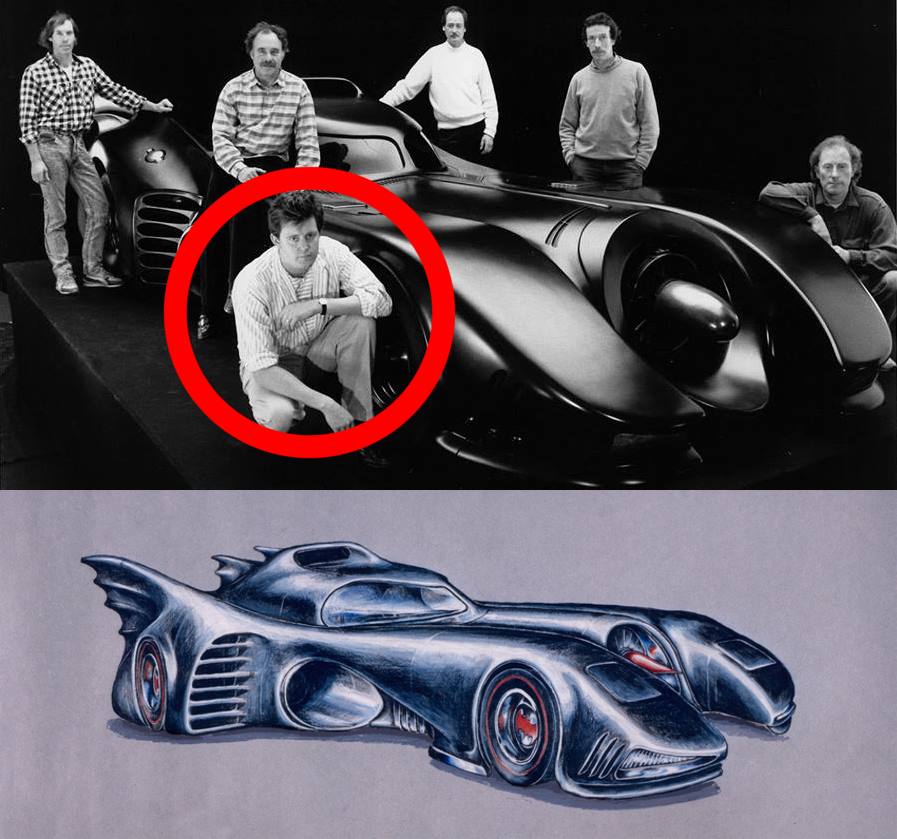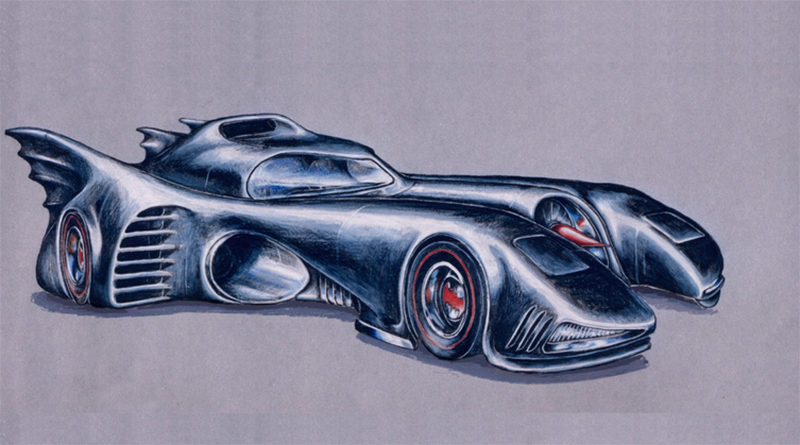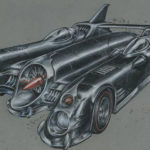Designing the 1989 Batmobile with Julian Caldow – Part 1
The LEGO Group’s 76139 1989 Batmobile is a wonderful homage to the vehicle from Tim Burton’s Batman. In this exclusive Brick Fanatics interview, concept artist Julian Caldow reveals how he designed the cinematic icon
In 1990, Tim Burton’s Batman won the Academy Award for Art Direction – and with good reason. The film has a complete aesthetic that makes it visually distinctive, as well as original in its approach to the superhero genre.
Anton Furst’s team included Julian Caldow, who came up with the design for the most character-infused vehicle in movie history. The Batmobile has such a recognisable and beloved design that 30 years after it graced screens, the LEGO Group realised it in exquisite detail as 76139 1989 Batmobile, following that set up with 76161 1989 Batwing.
In this exclusive interview, Julian explains how he came to be a part of the ‘bat-gang’ and developed an entirely new take on the Batmobile.
Brick Fanatics: What do you think of the LEGO version of your Batmobile?
Julian: When I was a kid doing LEGO stuff myself, you kind of had to imagine all those curves. You might have been able to get away with the Nolan one but not this one. It is pretty big.
I haven’t bought any LEGO for about 15 years. My kids are grown up now. I remember buying a whole bunch of Phantom Menace LEGO. [My son] had some great models but I don’t think he even built them all. Some of them are still up in the loft somewhere. You spend all this time getting all this stuff for Christmas, then they forget about it by Boxing Day.
Thinking back to working on Batman (1989), where were you in your career?
I met Anton Furst, the designer, sort of by chance, because I was working for a guy called Nick Dedman who had gone to the same college as me a few years before. I had been given his name and back then I was very interested in effects makeup, and the first four movies I did were doing prosthetics.
I did this film called High Spirits that was directed by Neil Jordan, and by that time I had pretty much decided I didn’t want to be in makeup anymore because there were people better at it and I wasn’t getting on very well with the chemicals. I was getting headaches and whatnot. On that film I arranged to go and meet Anton because I wanted to get into the art department and he looked at my folio, my illustrations. I didn’t really know very much about how the art department worked.
He said, ‘The next thing we’re doing is this Batman film, maybe you want to get on that.’ I can’t remember the period of time that passed but I got on that film and I started working on some of the buildings, some of the facades for the very first incarnation of the backlot set. I didn’t really have a grasp on scale, the actual proportions and stuff like that, so I think a conversation went on behind my back saying, ‘Get him the hell off that.’ I don’t know for sure but there were a lot of really good art directors on that, and they probably didn’t want me messing things up.

How did you develop the design of the Batmobile?
There was something in my folio that I had drawn, for this imaginary film that didn’t exist, with this hovering car with these two big intakes at the front [and] this wraparound screen. Anton just came in after week two and said, ‘Do you want to have a crack at the Batmobile?’ and of course you didn’t have to be asked twice. I started off doing quite conventional cars really, along the lines of the old Adam West TV series, so you had quite an American car with fins and stuff like that. As we got into it Anton had much more ambitious ideas. It was not so much a car as a symbol of the Batman, so I had to take it to the next level.
I had been looking at cars by the illustrator Syd Mead cars, and various concept artists, but then I started looking at the American land speed record cars that have always fascinated me. There was one vehicle called the Green Monster and it’s got this enormous single intake with this spike coming out of it. I think the design turned into Thrust2, which was the British land speed record-breaker. Basically, it’s a rocket – that is where the inspiration for that came from.
There was a bit of Volkswagen Beetle going on at the back, because I liked the idea of it looking like a Beetle. I ripped off the cockpit from this thing I had done before I worked on the film, which was the idea of having a cockpit that looked a bit like the X-15, a thing that Neil Armstrong flew. He practiced going to space using this thing, which was launched off the bottom of a B52, and it has a very distinctive cockpit. If you look at the cockpit of that you can certainly see the influence on the cockpit of the Batmobile. I remember the X-15 always being one of my favourite jets as a kid. I was a bit of a jet nut – I still am.
Anton was very generous and helpful, [and] Tim Burton was very excited about doing it. I don’t think he had done anything remotely as huge before, and we just sort of ran with it. Terry Ackland-Snow was the art director on it, and he was kind of the liaison between John Evans – the special effects guy who was building the Batmobile – and the exterior look. They made a little maquette of it based on my concept. I don’t know where that original concept drawing is. I heard it belonged to Prince for a time and it is still in his estate – I don’t know that for a fact, but that is what I had heard.
All I’ve got is that little photograph of the illustration that’s on my website. Two excellent sculptors, Keith Short and Eddie Butler, built a little clay maquette. Then they built the whole thing full scale in polystyrene. For weeks and weeks it was being sculpted in a big shed at Pinewood. When it was cut into a shape that they liked, they took it to a fibreglass technician. I can’t remember his name – Lovell was his last name; there was an art director on our film called Ray Lovell and this guy was his brother and he was a fibreglass technician. They built the exterior of it.

A little interesting anecdote… I had made sure I knew the height of Michael Keaton so that he could sit inside it – it was a very, very tight fit because it was quite low. Because of my inexperience what I hadn’t taken into account was his bat-ears, and I don’t even know what solution they came up with. I think they may have lowered the seat and taken some padding off the ceiling… I’m not quite sure. I remember thinking, ‘This is my introduction to the art department and Batman doesn’t actually fit in his own Batmobile.’
Nigel Phelps – who is now a designer in his own right – came up with the idea of sliding the cockpit down the bonnet. I couldn’t figure out how to put a door on the design that I had done. I was thinking maybe there would be gull wing doors, but it just wouldn’t have worked because the cockpit was in the centre of the vehicle. It was Nigel who came up with the idea of sliding the cockpit down the bonnet and then just leaping in, which was kind of in-keeping with the old TV series as well, because you remember them not opening the doors and just jumping in.
It was my first art department so I wasn’t reading the script and seeing what was asked of the Batmobile in the way that one should, I just made this cool-looking thing. But there were a lot of hands on it. I can’t claim the Batmobile was mine, it was really Anton’s baby. Anton was such a generous designer, just letting you run with an idea. He was fabulous – well, the whole crew [were]. Lots of the people I worked with on that became designers in their own right, so it was a talented bunch of people.
It was done very quickly as I remember. It all went pretty smoothly, everybody was on the same page. It was a very pleasant experience – of course I had never done anything like that before, and I have never done anything like that since.
The second part of this exclusive interview will be appearing at Brick Fanatics soon.
76139 1989 Batmobile and 76161 1989 Batwing are available now at LEGO.com. To support the work of Brick Fanatics, please buy your LEGO sets from LEGO.com using our affiliate links.
Author Profile
-
Graham was the BrickFanatics.com Editor up until November 2020. He has plenty of experience working on LEGO related projects. He has contributed to various websites and publications on topics including niche hobbies, the toy industry and education.
Follw Graham on Twitter @grahamh100.








Nick Dudman, not Nick Dedman.
Nick has had a long career, including designing the Joker makeup for Jack Nicholson (Batman 1989), and the nightmare Batman from ‘Batman Begins’.